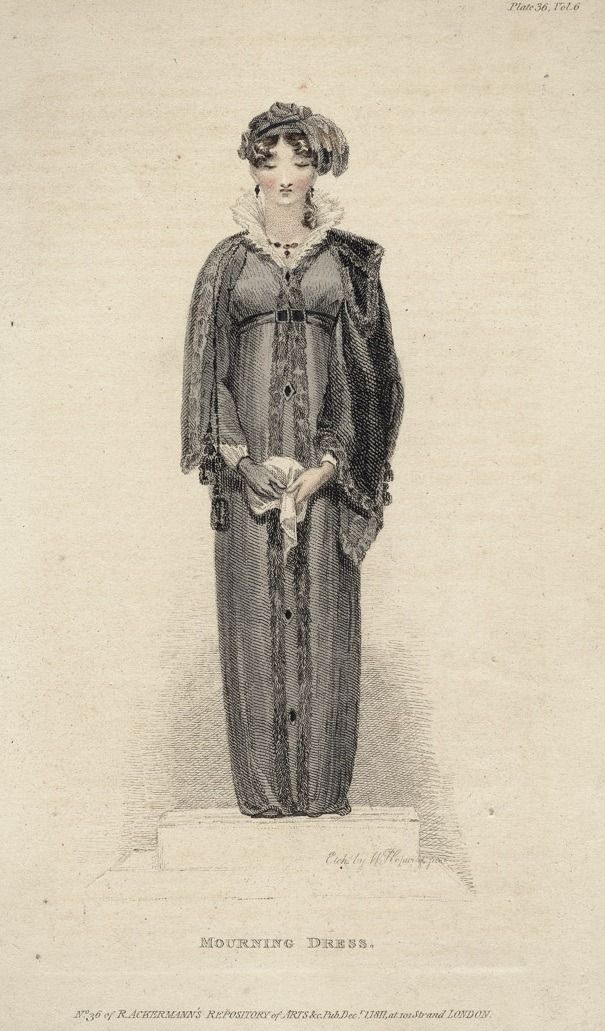| Geri Kelly |
Thanks for your question, Geri, and for being a Regency Reader!
I have several complicated answers for a seemingly simple question. Partly because it depends. It depends on whether or not the household also has a lady, or if it is an all male household. It depends on whether other guests are present or not. And it depends on her class, what year we are talking about, and what the relationship is between the young widow and the household.
Most of the etiquette books available today are from the Victorian era, which is known to be a little more restrictive than the Regency era.
We answered a similar question many years ago pertaining to a young woman living with male relatives. Much of the etiquette discussed in that post pertains, however, to unmarried ladies and focuses on the dual role of the chaperone to protect the reputation/chastity of the unmarried woman and help promote marriage. Obviously, a young widow would not be considered to be a virgin and had already been married, so two of the concerns would be eliminated. The real question is, then, whether a young widow needed to worry about her reputation.
The early 19th century saw the tides of inheritance change favorably for widows, ensuring more financial freedom (Chused, 1982). While some families may have wanted to exert influence and control back over their young daughters once widowed, depending on her husband’s will and the dissolution of the estate, the young widow may have had new financial freedoms to exercise power over her own life.
This young widow may have elected, if she could afford it, to hire a companion to serve in place of a chaperone as symbol of respectability. The reality, however, was that a widow left in “comfortable circumstances” was “the exception to the rule” (Behrendt, 482). More interesting, however, was that data from the late Georgian and early Regency era suggests that a large number of English families were single headed households, and at least 14% of them were widows (Behrendt, 2005). Furthermore, evidence suggests that 70% of widows were the head of household and so it was common for a widowed woman to be her own master (Behrendt, 2005). This, naturally, presented opportunities for widowed women to determine their own destiny, both economically and socially.
There were a fair amount of cautionary tales about “merry widows” in the era, women who represent sexual freedoms that were abhorrent because they challenged the status quo (Behrendt, 2005). Women in the era would have been aware of this, and would have considered respectability as paramount to maintaining certain freedoms in Society and economically.
So a young widow, if she was a guest in a house without a lady and in the presence of young men who may be seen as a threat to her respectability, may enlist the help of a companion (another married or widowed female relative, for example) to maintain her reputation (regardless of whether or not she actually chose to engage in a liaison with one of the young men). However, if the household was a relative or included a married couple, it may have been perceived as enough “protection”. At a house party with lots of guests, the young widow would be exposed to more prying eyes and therefore may have wished to promote an air of propriety by being accompanied by a companion or relative. It would also depend on whether or not the young widow intended on remarrying and securing a good match (Poppel, 1995).
In the strictest sense, a young widow was never in need of a chaperone, but by in large women seldom were able to be solitary and freely mingle in Society. However, the freedoms offered to widows may have been enough incentive to occasionally enlist an Aunt or sister or cousin to play propriety.

References:
Behrendt, Stephen. (2005). Women without Men: Barbara Hofland and the Economics of Widowhood. Eighteenth-Century Fiction. 17. 481-508. 10.1353/ecf.2005.0039.
Chused, R. (1982) Married Women’s Property Law: 1800-1850 Retrieved: Married Women’s Property Law: 1800-1850 (nyls.edu)
Curran, C. (1993). Private Women, Public Needs: Middle-Class Widows in Victorian England. Albion: A Quarterly Journal Concerned with British Studies, 25(2), 217-236. doi:10.2307/4051453
Frans Van Poppel. (1995). Widows, Widowers and Remarriage in Nineteenth-Century Netherlands. Population Studies, 49(3), 421-441. Retrieved August 4, 2021, from http://www.jstor.org/stable/2175256
Jalland, P. (1996-11-07). Death in the Victorian Family. : Oxford University Press. Retrieved 4 Aug. 2021, from https://oxford.universitypressscholarship.com/view/10.1093/acprof:oso/9780198201885.001.0001/acprof-9780198201885.
Dowagers and Widows in 19th C. England | Jane Austen’s World (janeaustensworld.com)
The Real Widows of the 19th Century Revealed | Perspectives on History | AHA (historians.org)
Have more questions about the 19th Century? Ask us here!
Enjoy our content? Buy us a coffee and help us improve the website!









